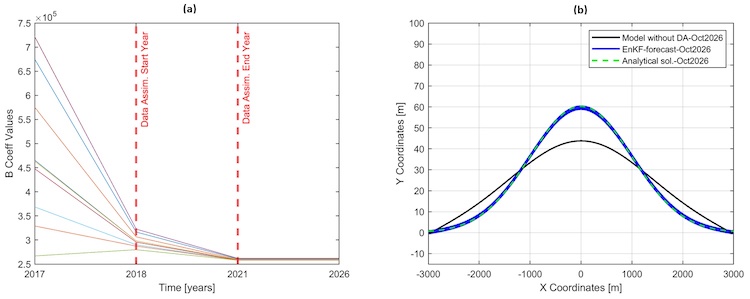M. Saleh1*, A. Elghandour1, D. Roelvink1, 2, 3, S. Vitousek4, J. Reyns1, 2, G. Corzo1, G. El Serafy2, 3
1 IHE Delft,
2 Deltares,
3 Delft University of Technology.
4 U.S. Geological Survey,
Introduction
The main focus in this research is to implement the sequential data assimilation (DA) method, Ensemble Kalman Filter, in the free-form ShorelineS coastline evolution models (Roelvink, et al., 2020). ShorelineS is flexible and can simulate the effect of hard structures and river inlets, also can handle the splitting and joining of shorelines with distinctive sections. Although having all these advantages, it makes it quite challenging to apply DA in the model. So, experiments to a simple one-line model was implemented first. Then DA in ShorelineS was applied afterwards.
Methods
A quasi-transect approach was implemented: by sequentially transform the ShorelineS simulations onto a set of transects created across the shoreline ensemble members. The intersection points between transects and each ensemble member will be used in the EnKF assimilation process alongside with the model calibration coefficient, "B" coefficient. Several validation tests were made, for example: twin experiment and Pelnard-Considere-based groin test (for the simple model). While in ShorelineS, longshore dispersion of a beach nourishment test. In addition to, the application of the developed model in spits formation test using spread of high angle of wave incidence and a case study of the well-monitored, large-scale "Sand motor" nourishment in the Netherlands are in progress.
Results
Twin experiment and Pelnard-Considere-based groin tests on the simple model after adding data assimilation showed great improvements in model results' BSS values, and confirmed the suitability of EnKF in parameterization process. This was very encouraging to apply EnKF on ShorelineS. In longshore dispersion of a beach nourishment test on ShorelineS: "B" coefficient was successfully calibrated as shown in fig (1.a). As a result, forecast results, presented in fig (1.b), were significantly matching analytical solution, especially in presenting both erosion and accretion features.

Fig (1.a) shows "B" coefficient calibration in different ensembles through time. Fig (1.b) shows comparison between ShorelineS model, with and without DA, forecasting results.
References
Roelvink D, Huisman B, Elghandour A, Ghonim M, Reyns J (2020) Efficient modeling of complex sandy coastal evolution at monthly to century time scales. Frontiers in Marine Science 7: 535
I. Surname1*, F.N. Another-Surname2 , Y. Next-Surname2
1 University Name, Country; 2 Organization Name, Country
* Corresponding author: mail.name@organization.org


